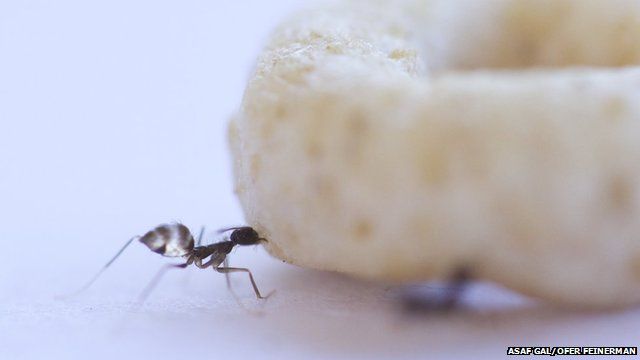'Leaders and lifters' help ants move massive meals
- Published

Scientists in Israel have discovered how ants co-operate to move big chunks of food back to their nests.
A large team of ants does the heavy lifting but they lack direction, while a small number of "scouts" intervene and steer for short periods.
They appear to have a mathematically perfect balance between individuality and conformism, the researchers said.
The discovery was made by analysing videos of ants carrying oversized food items, including Cheerios.
Published in the journal Nature Communications, the study used a very common species known as the longhorn crazy ant.
The species' name refers to the way the little creatures dash about, frequently changing direction with apparently aimless abandon.
But the new findings suggest that the level of aimlessness in these ants' behaviour is in fact very finely tuned.
Pushy scouts
"The group is tuned to be maximally sensitive to the leader ants," said the paper's senior author Dr Ofer Feinerman, a physicist at the Weizmann Institute of Science in Rehovot.
He said the ants seem to have just the right amount of erratic individualism. About 90% of the time, they will "go with the flow" and pull in the same direction as everybody else; the other 10% of the time they live up to their name.
That means that on the whole, each ant transport team works together and avoids a fruitless tug-of-war. But crucially, their erratic streak leaves a degree of instability - and this allows a single ant with new information to join in and change the direction.
Watch as a "scout" ant joins in and steers this Cheerio transport team towards the nest, which is to the left (footage: Ehud Fonio, Ofer Feinerman)
"This leader that comes along, she doesn't have to introduce herself, she doesn't have to be stronger than the rest - she just has to pull in the correct direction," Dr Feinerman told BBC News.
"The only communication in the system is the forces that they feel through the object."
So while it is the sheer number of ants on the team that determines how fast the tidbit gets transported, the navigation is supplied by these "scouts".
'Stealing cat food'
To test out their model, Dr Feinerman and his colleagues tried the ants in some extreme situations - giving them objects much bigger than anything they would normally shift.
"The prediction that the model gave us is that we can play with this mix of conformism and non-conformism," he said. "If you move something huge, you need many, many more ants. And then the force that each ant feels through the object is much stronger. So... all the ants feel a stronger urge to act as conformists."
Sure enough, when the ants were presented with silicon discs 8cm or even 16cm across, they lost their erratic streak altogether and everybody pushed in the same direction. The discs moved in very smooth, straight lines - but navigating around obstacles became impossible.
Their system works best, Dr Feinerman explained, for medium-sized objects (to an ant) of about 1cm, or "about what they can squeeze through the nest entrance".
So the Cheerios used in the experiment were perfect. And oddly enough, so is cat food - which is how the whole project got started.
"[One of my colleagues] moved to a new apartment at the same time as he joined the lab, and there were ants in his apartment. He saw the cat food moving - they were stealing the cat food.
"He came back with a movie of it the next day. We watched it and we realised it was very interesting… We've been working on it for four years now."
Prof Nigel Franks, who runs the Ant Lab at the University of Bristol, said the study was "a really exquisite piece of work" and a fine example of ideas from physics being applied to biological questions.
"When ants are moving huge objects, one of the things that people have noticed… is how chaotic it can appear, with ants randomly joining a group and then leaving it again," Prof Franks told the BBC.
"What this study shows really beautifully is that those ants that join in briefly can be the informed ones that know which way the object should be going - so they give a little bit of steerage periodically, and keep things more or less on track.
"I think this very quantitative and beautiful approach illuminates a curious bit of natural history that we didn't previously understand."
Follow Jonathan on Twitter
- Published31 March 2015
- Published7 August 2014
- Published14 August 2013
- Published21 May 2013
- Published25 August 2011